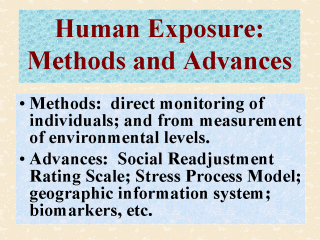| front |1 |2 |3 |4 |5 |6 |7 |8 |9 |10 |11 |12 |13 |14 |15 |16 |17 |18 |19 |20 |21 |22 |23 |review |
 |
In some cases
(especially when direct measurements are not available), human exposures to a certain
toxic agent can be measured indirectly through use of environmental concentrations and
some physiological intake or uptake parameters. For instance, multiplying the air level of
a toxic agent by an individualís hourly inhalation rate would give an estimate of the
amount of an air pollutant taken into his or her respiratory tract in one hour.
Multiplying the food residue levels by an individualís daily consumption rate would also
provide an estimate for his or her daily dietary intake of those residues. In psychosocial epidemiology, example advances that are relevant to human exposure assessment include the Social Readjustment Rating Scale (Holmes and Rahe, 1967) used to measure the amount of stress from life events, and the more recent revised stress process model (Pearlin, 2000) designed to associate the individualís health with exposure to stress and other factors. For the other branches of epidemiology, in addition to having better designed studies or surveys and hence higher quality data nowadays, perhaps the most widely-mentioned, if not widely-accepted, tool for human exposure assessment is biological markers. Recent advances in analytical chemistry and geographic information system (GIS) too contribute a great deal to environmental monitoring. For example, a chemical that could only be quantified at PPM (parts per million) before can now be detected at PPB. The use of a GIS will also improve the predicted environmental concentrations by its aiding in selection of appropriate meteorological data and source location. |